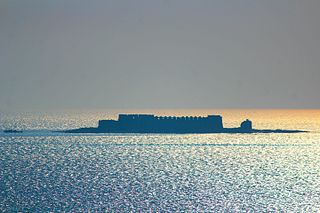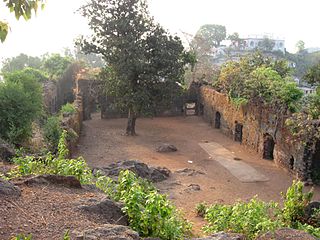
Navi Mumbai is a planned city that is adjacent to Mumbai, located in the Konkan division of Maharashtra state, on the mainland of India. Navi Mumbai is situated across two districts, Thane & Raigad. It is a part of the Mumbai Metropolitan Area.

Vasai is a historical place and city located in Palghar district; which was partitioned out of the Thana district in 2014. It also forms a part of Vasai-Virar twin cities in the Konkan division, Maharashtra, India.

Sinhagad is an ancient hill fortress located at around 49 km southwest of the city of Pune, India.

Kanhoji Angre, also known as Conajee Angria or Sarkhel Angré was a chief of the Maratha Navy in present-day India. Kanhoji became known for attacking and capturing European merchant ships and collecting jakat, seen by Europeans traders and colonists as ransoming of their crews. British, Dutch and Portuguese ships often fell victims to these raids. Despite attempts by the Portuguese and British to put an end to his privateering activities, Angre continued to capture and collect jakat from European merchant ships until his death in 1729. Kanhoji's naval prowess in capturing dozens of European trading ships and avoiding capture has led to many historians to appraise Kanhoji as the most skilled Indian navy chief in the maritime history of India.

The Sewri Fort is a fort in Mumbai built by the British at Sewri. Built in 1680, fort served as a watch tower, atop a quarried hill overlooking the Mumbai harbour.
The Mazagaon Fort was a British fort in Mazagaon, Bombay, in the Indian state of Maharashtra, built around 1680. The fort was razed by the Muslim Koli general, Yakut Khan in June 1690. The fort was located at the present-day Joseph Baptista Gardens, atop Bhandarwada Hill outside the Dockyard Road railway station.

Murud-Janjira is the local name of a famous fort and tourist spot situated on an island just off the coastal town of Murud, in the Raigad district of Maharashtra, India.

Castella de Aguada, also known as the Bandra Fort, is a fort located in Bandra, Mumbai. "Castella" is a misspelling for Portuguese "Castelo" (castle), although it seems its Portuguese builders actually called it Forte de Bandorá. It is located at Land's End in Bandra. It was built by the Portuguese in 1640 as a watchtower overlooking Mahim Bay, the Arabian Sea and the southern island of Mahim. The strategic value of the fort was enhanced in 1661 after the Portuguese ceded the seven islands of Bombay that lay to the immediate south of Bandra to the English. The name indicates its origin as a place where fresh water was available in the form of a fountain ("Aguada") for Portuguese ships cruising the coasts in the initial period of Portuguese presence. The fort lies over several levels, from sea level to an altitude of 24 metres (79 ft). Castella de Aguada has been featured in several Hindi films, such as Dil Chahta Hai and Buddha Mil Gaya.

Suvarnadurg is a fort that is located between Mumbai and Goa on a small island in the Arabian Sea, near Harnai in Konkan, along the West Coast of India, in the Indian state of Maharashtra.

Chimaji Balaji Bhat (1707–1740), commonly referred to as Appa or Bhau, was the son of Balaji Vishwanath Bhat and the younger brother of Bajirao Peshwa of Maratha Empire. He was an able military commander who liberated the western coast of India from Portuguese rule. The high watermark of his career was the capture of Vasai fort from the Portuguese. He was known to run strategy for the Maratha Empire and was known to plan all the battles for Bajirao.
Murud is a town and a municipal council in Raigad district in the Indian state of Maharashtra. Situated at a distance of 150 km (93 mi) from Mumbai, Murud is a tourist destination. The Palace of Nawab is located in Murud. The palace was built in 1885 for administration purposes. The palace is still owned by the descendants of the Nawab and is a private property.

Padmadurg, also known as Kasa fort, is one of five historical sea forts built by Shivaji I and located in Raigad District Maharashtra, India. It was built by the Marathas to challenge another seaport, Janjira which was controlled by the Siddis.

Ghodbunder Fort is a fort located in Ghodbunder Village, Thane, Maharashtra, India, on the hill just south of the Ulhas River. It was built by the Portuguese, occupied by the Maratha Empire, and became the East India Company's district headquarters. The place was called Ghodbunder because it was where the Portuguese used to trade for ghode (horses) with the Arabs. Hence the name Ghodbunder: ghode (horses) & bunder (port).

Vijaydurg, the oldest fort on the Sindhudurg coast, was constructed during the regime of Raja Bhoja II of the Shilahar dynasty and restructured by Shivaji I.

The Central Business District of Belapur is a node of Navi Mumbai. The Navi Mumbai Municipal Corporation is headquartered in Belapur. The Reserve Bank of India maintains a branch office at CBD Belapur. This area is one of the fastest developing regions in Navi Mumbai in terms of new residential and commercial construction projects. CBD Belapur is connected to other parts of Mumbai through railways, BEST & NMMT buses. It had a ferry service for traveling to Elephanta caves from Sector-11.
Gowalkot is a small fort located on the southern bank of Vashishti River, about 10.0 km (6.2 mi) from Chiplun in Maharashtra, India. This fort is guarded by the river on three sides and a trench on the fourth side. Its population which includes Hindus, Muslims, and Buddhists. According to old natives of Gowalkot, the history of Gowalkot goes back to a King, who was Hindu and finally was converted in Muslim, his surname was "Chougle", and most of the land in Gowalkot is owned by the Chougle family. All other owner of land in Gowalkot must have either received the land as gift [or bought] from Chougle family must have lost in "kul kaida" a rule by the government.

The Maratha Navy was the naval wing of the armed forces of the Maratha Empire, which existed from around mid-17th century to mid-18th century in the Indian subcontinent.
Bankot Fort / Himmatgad Fort/ Fort Victoria is a fort located 47 km from Dapoli, in Ratnagiri district, of Maharashtra. This fort is an important fort in Ratnagiri district. The Fort is located on a prominent and commanding point for guarding the trade route along the Savitri River, which runs till, Mahad which was a busy route in medieval times. It is a fort located on a hill near the sea.

Tulaji Angre, called Tulajee Angria by English historians was the grand admiral of the Maratha Navy and ruler of Colaba State in modern-day India. Similar to his famous father Kanhoji Angre, he too was an extremely skilled admiral and attacked several European trading ships. His achievements and naval prowess are considered to be greater than that of his father by some scholars and chroniclers. On various occasions he fought against the English, Dutch, Siddis And Portuguese maritime Powers. However, he alienated himself from the Maratha Peshwa, Balaji Baji Rao which led to his capture by the East India Company and Peshwa's forces at the Battle of Vijaydurg in 1756.
Tarapur Fort is a fortress situated in Tarapur in Palghar District in the Indian state of Maharashtra.
















